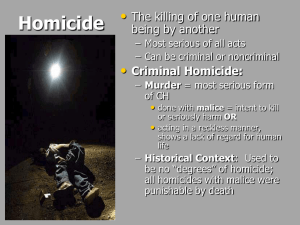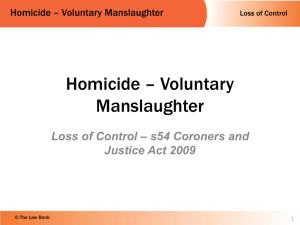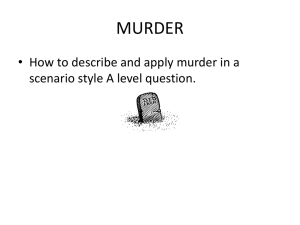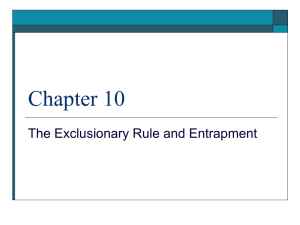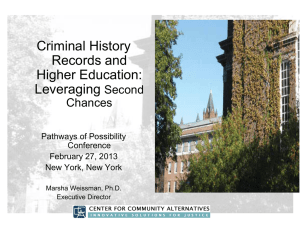powerpoint
advertisement
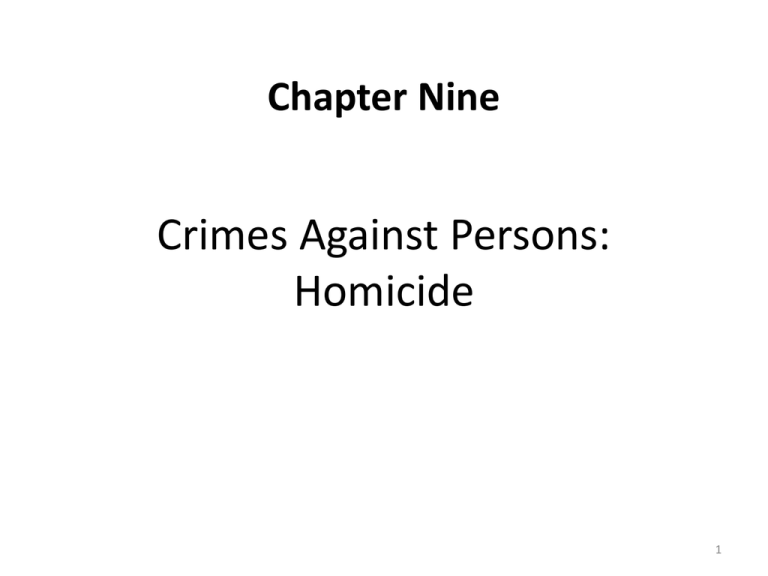
Chapter Nine Crimes Against Persons: Homicide 1 Chapter Nine: Learning Objectives • Understand that criminal homicide is different from all other crimes because of the finality of its result: the death of the victim. • Appreciate that most of the law of criminal homicide is about grading the seriousness of the offense. Grading murder into first and second degree is important because only first-degree murder qualifies for the death penalty. 2 Learning Objectives (continued) • Appreciate that the meaning of person is integral to homicide law and understand how that presents problems at both ends of the life cycle. • Understand how degrees of murder developed through history and their relation to capital punishment. • Understand how most criminal homicide statutes apply to corporations, but prosecutions are rare. 3 Learning Objectives (continued) • Understand that the heart of voluntary manslaughter is an intentional, sudden killing triggered by an adequate provocation. • Know that provocation is not an excuse for criminal homicide; it only reduces the seriousness of the crime and the punishment to allow for human frailty. • Know that the central elements in involuntary manslaughter are its actus reus, mens rea; causing the criminal harm of death. 4 Learning Objectives (continued) • Understand that criminal negligence homicide statutes cover a wide field, including the most common, unintentional deaths caused by operating vehicles and firearms, but also medicine, handling explosives, delivering dangerous drugs, allowing vicious animals to run free, failing to care for a sick child, and not providing fire exits in businesses. 5 Homicide in Context • Criminal Homicide is rare • Much of the law discussed earlier grew out of criminal homicide cases – mens rea issues – Self defense issues • Three step analysis of criminal liability grew out of the work on criminal homicide: – criminal conduct? – Without justification? – Without excuse? 6 Homicide • Most of homicide discussions deal with issues of grading the crime because the punishment for criminal homicide depends on the degree of murder or the type of manslaughter committed – Issue of how much punishment should we inflict upon people who kill other people? • Capital punishment? • Lifetime incarceration? • Fines? – Tremendous variances among states and federal governments concerning classifying and punishing different types of criminal homicide 7 Defining Human Being • Criminal homicide involves killing a person • Requires a definition of person – When does life begin? – When does life end? 8 When does life begin? • Common law followed the born alive rule – To be a person (and thus to be capable of being a homicide victim) the baby had to be born alive – Exception: People v. Chavez (1947): • Holding: viable child in the process of being born was a human being within the meaning of the homicide statute regardless of whether the process was complete – Keeler v. Superior Court (1970): • California court refused to extend the definition of person to include fetuses born before the birth process. Overturned conviction of Keeler who had caused death of wife’s unborn fetus by kicking her. 9 State v. Cotton (2000) Summary of case holding • Because baby was born alive, it didn’t matter that defendant had caused the injury leading to her death while she was still in utero. 10 When does life begin? • Some states have revised existing homicide statutes to include persons and fetuses as potential homicide victims • Some states have created the crime of feticide, directed at the killing of fetuses – Viability? – Quickening? – At conception? 11 When Does Life End? • Historically death occurred when the heart and breathing stopped • Modern medicine makes this determination more complicated—organ transplants, artificial life support • Accelerating a persons death is criminal homicide – Example: State v. Fiero (1979)…a doctor removing an organ too soon 12 When does life end? • Brain death – Complicates the criminal homicide determination – Uniform Brain Death Act • Individual who has suffered irreversible cessation of all brain functions, including those of the brain stem, is dead • Coma – Troubling cases 13 Doctor Assisted Suicide • Euthanasia = helping others die • Historically assisting another to commit suicide was criminal homicide (and still is in most jurisdictions) • Passive euthanasia = failing to take extraordinary measures to keep someone alive • Active euthanasia = deliberate acts to cause death 14 Doctor Assisted Suicide • Voluntary euthanasia = dying person makes rational request • Involuntary euthanasia = no request by dying person, but decision by family/court for – Good reasons = beneficent – Bad intentions = malevolent 15 Doctor-Assisted Suicide • Arguments Against: – Intrinsically immoral – Slippery Slope • Mistakes, malevolent purposes, potential for wrong diagnosis, threat of non-mercy killings are too great to justify an exception. – Societal interests at stake 16 Doctor-Assisted Suicide • Arguments in Favor – Not an argument FOR euthanasia, its an argument against pain – Compassion – Constitutional Right • Presumption of bodily integrity • liberty interest guaranteed in 5th and 14th Amendments include the right to die 17 Constitutional Right to Doctor-Assisted Suicide • Washington v. Glucksberg (1997) – U.S. Supreme Court upheld Washington’s legislative ban on doctor assisted suicide • Gonzalez v. Oregon (2005) – U.S. Supreme Court upheld Oregon’s Death with Dignity Act • Washington Initiative (2008) voters enacted a death with dignity act modeled on Oregon’s law 18 Doctor Assisted Suicide and Criminal Law • Assisted suicide is difficult to distinguish from first degree murder • But, rationales for condemning murder are not presented in doctor assisted suicide – Doesn’t violate a person’s interest in continuing to live – Isn’t necessarily a destructive force in society • Opposing viewpoints are irreconcilable 19 Public Opinion • Public opinion about doctor-assisted suicide is divided – 2007 Gallup Poll: • 56% favor • 38% oppose 20 Murder • Homicide divided into – criminal homicide and – noncriminal homicide: • Justifiable homicide • Excusable homicide • Common Law divided criminal homicide into – Murder • Killing a person with malice aforethought – Manslaughter • Killing a person without malice aforethought 21 Common Law Murder Blackstone 1769 “When a person • • • • • Of sound memory and discretion Unlawfully killeth Any reasonable creature in being Under the king’s peace With malice aforethought, either express or implied” (Sir Edward Coke) – Note: At common law, the death had to occur within a year and a day of the offender’ acts 22 Malice Aforethought • Malice = specific intent, killing on purpose with ill will, hate or spite • Aforethought = acts planned in advance – Express malice aforethought (early common law) – Implied malice aforethought (as law developed) 1. 2. 3. 4. Intentional killings that weren’t premeditated Unintended killings that occurred during a felony Extreme reckless killings (depraved heart murder) Intent to create serious bodily injury murder 23 Elements of Murder A Result Crime • Actus reus – the act of killing • Mens rea – killing with purpose, knowledge or extreme recklessness • Causation-the act caused the death • Death • Attendant circumstances 24 Kinds and Degrees of Murder • Not formally divided under degree in English common law—all were felonies – Benefit of clergy—developed to mitigate the harshness of the punishment (Most crimes were capital felonies, and criminals were hanged) – Dividing murders into degrees continuation of idea that not all felons, not even all murderers should be executed • U.S. colonies/states, degrees of murder were created by legislatures 25 Degrees of Murder • Most states divide homicide into two degrees, some divide it into three • Model Penal Code doesn’t use degrees, but divides murders according to mental attitudes (Purpose, Knowing, and extreme recklessness) 26 First Degree Murder • Premeditated, deliberate, intent to kill murder • Felony murder • Only crime for which death penalty can be imposed (capital cases) • Death penalty issues complicate murder law – Supreme Court decisions have resulted in following • • • • Mandatory death sentences are banned Unguided discretionary death penalty decisions are banned Mitigating factors are required Additional aggravating factors are allowed 27 First Degree Murder, death penalty • Model Penal Code recommendations re: death penalty – Bifurcation of the guilt determination phase and the sentencing phase – Criteria for decision is limited and announced before the decision to sentence the defendant to death • Aggravating factors (see listing in text p-290) • Mitigating factors (see listing in text p-290) • Aggravating and Mitigating factors must be considered before making decision 28 First Degree Murder • Mens Rea – Willful, deliberate, and premeditated murder (The “grand criterion of murder” – Something more than the intent to kill – Often disagreement what deliberate and premeditated mean – Willful = intent to kill – Premeditated = sufficient time to enable the mind to frame the design to kill – Deliberate = fully conscious of purpose and design 29 First Degree Murder • Case examples with definitions of willful, premeditated and deliberate: – Commonwealth v. Drum (1868) – People v. Anderson (1968) • Specific intent plus real premeditation-deliberation definition – Macias v. State (1929) • Willful, premeditated, deliberate = specific intent to kill 30 Byford v. State (2000) Summary of case holding • Court found sufficient evidence to establish deliberation and premeditation on defendant’s part. • Distinguishes between premeditation and deliberation – Willful = intent to kill – Deliberation = process of determining upon a course of action to kill as a result of thought, including weighing the reasons for and against the actions – Premeditation = design, determination to kill, distinctly formed in the mind by the time of the killing • Court found torture (aggravating circumstance) requires that murder intended to inflict pain beyond the killing itself….and that jury could find facts to support that 31 State v. Snowden (1957) Summary of case holding • Court determined that the time needed to remove the knife from his pocket, open it and cut the victim’s throat was sufficient time to show premeditation and deliberation. Thus, the court sustained the defendant’s murder conviction 32 Actus Reus of First Degree Murder • Voluntary act of killing • many forms of killing • Many statutes require “heinous atrocious or cruel” acts to accomplish the actus reus of first degree murder – Example: State v. Duest 33 State v. Duest (1985) Summary of case holding • Facts of case were sufficient to find that defendant engaged in atrocious heinous and cruel murder – Multiple stab wounds – Statements that he intended to roll gay guys – Stole victim’s jewelry 34 Second Degree Murder • Second Degree murder statutes include – implied malice crimes created by common law judges (and retained by state statute) – felony murders – intent to inflict serious bodily injury murders – depraved heart murders • Unintentional but extremely reckless murders differ from reckless mansalughter – Killing very very, very, very recklessly • Some state statutes make second degree murder the “catch all” category 35 People v. Thomas Summary of case holding • Malice or intent to kill may be inferred from the acts of the defendant. • The intent to kill may be implied where the actor actually intends to inflict great bodily harm or the natural tendency of his behavior is to cause death or great bodily harm. 36 Felony Murder • Unintentional deaths that occur during the commission of some felonies • States vary as to what felonies are included— some list the felonies – See Maryland’s Felony Murder Statute • Variation regarding whether co-defendant’s death can be basis for felony murder – Third party exception; resisting victim exception People v Hudson (2006) 37 Felony Murder • Some states say that felony murder applies to “inherently dangerous felonies.” – Approach 1- Determine whether felony is inherently dangerous by looking at the crime in the abstract – Approach 2-determine whether the felony is inherently dangerous by looking at the facts presented in the case. (case by case approach) 38 Felony Murder Mens rea • Felony murder does not require the intent to either kill or inflict serious bodily injury • In that respect they are sometimes considered “strict liability” crimes…. • Remember that the actor must have the requisite mens rea to commit the underlying felony 39 People v. Hudson (2006) Summary of case holding • Court examined whether the defendant was guilty of proximate cause theory of felony murder, and spent a great deal of time discussing the causation element. • The court stated, “It is immaterial whether the killing…Is intentional or accidental or committed by a confederate without the connivance of the defendant or even by a third person trying to prevent the commission of the felony. . . “ (as long as he is proximate cause). • Jury was correctly instructed as to proximate cause. 40 People v. Phillips (1966) Summary of case holding • Applied the “inherently dangerous in the abstract” approach to felony murder and determined that fraud is not a crime which is inherently dangerous in the abstract (although in this case, defendant’s actions were probably inherently dangerous) 41 Corporate Murder • Corporations commit murder through the acts of their agents – Ford Pinto – Autumn Hills Convalescent Center • Concerns about corporate murder stem from concerns about vicarious liability in general (imputing acts of one to another) 42 People v. O’Neil (1990) Summary of case holding • Court overturned appellate court’s decision ruling that corporate officers could not be guilty of involuntary murder. • The supreme court looked at the actions of the officer’s and determined that the officers were responsible for running the plant the way they did, they knew of the dangers to their employees. • “A corporation is criminally responsible whenever any of its high managerial agents possess the requisite mental state and is responsible for a criminal offense while acting within the scope of his employment.” 43 Manslaughter • Voluntary Manslaughter • Intentional killing • Done in the sudden heat of passion – Timing of whether this was still in heat of passion is determined by the facts of the case • Without a cooling off period – Objective test of cooling off time (would a reasonable person under the same circumstances had time to cool off) – State v. Flory (1929) – Informed his wife was raped by her father…walked all night directly to the father’s home and killed him…the court ruled Flory had not cooled off…the heinous combination of incest and rape was enough to keep a reasonable person in a murderous rage for at least several days. 44 Manslaughter • Voluntary Manslaughter - Continued • Because of legally adequate provocation – Provocation is both subjective (defendant himself was provoked) and objective (reasonable person would be provoked) – “Adequate Provocation” means that which is “calculated to inflame the passion of a reasonable person and tend to cause that person to act for the moment from passion rather than reason” – Types of provocation recognized as “adequate” • Mutual combat • assault and battery, • trespass and • adultery 45 Manslaughter • Voluntary Manslaughter • Paramour rule: Common law rule that held that a man who found his wife in the arms of her lover was not guilty of murder but rather voluntary manslaughter (presumed that this would be adequate provocation which would cause sudden heat of passion) 46 Manslaughter • Voluntary Manslaughter • Provocation by “Words” – Words cannot be provocation (common law rule), but there may be statutes that allow words to suffice for provocation – Example: Minnesota statute in text - never – Last straw rule, smoldering or slow burn resentment – words detonate a last straw rule: Dennis v. State (1995) • Provocation had to cause the sudden heat of passion 47 Model Penal Code Manslaughter • Criminal homicide constitutes manslaughter when: a. It is committed recklessly; or b. A homicide which would otherwise be murder is committed under the influence of extreme mental or emotional disturbance for which there is reasonable explanation or excuse. – The reasonableness of such explanation or excuse shall be determined from the viewpoint of the person in the actor’s situation under the circumstances he believes them to be. 48 Commonwealth v. Schnopps (1983) Summary of case holding • Schnopps argued that he acted in sudden heat of passion (wife’s adultery and words) and therefore should have been convicted of lesser degree of murder. • Court concluded that the jury had sufficient evidence to find that defendant acted with deliberately, premeditated malice aforethought. (could have found that he lured his wife there, that he planned to kill her based upon statements made to co workers) 49 Involuntary Manslaughter • • • • Actus reus –killing Mens rea –unintentional killing Causation Death 50 Involuntary Manslaughter 2 Types: 1. Criminal negligence manslaughter – Generally includes both recklessness and negligence (notwithstanding the name) 2. Unlawful act manslaughter (aka misdemeanor manslaughter) – Deaths that occur during the commission of unlawful acts 51 Criminal Negligence/Vehicular/Firearms Manslaughter • Criminal negligence manslaughter – Actus reus – defendant’s acts create a high (substantial and unjustifiable risk of death or serious bodily injury) – Mens rea – defendant is aware the risk of death or serious bodily injury is high but commits the acts anyway • Most of these crimes involve unintentional deaths caused by operating vehicles or firearms (aka vehicular homicide, or criminally negligent homicide) 52 State v. Mays (2000) Summary of case holding • Court held that although defendant did indeed commit vehicular homicide; it opined that defendant was not shown to have committed the worse form of vehicular homicide, so he couldn’t be receive the sentencing maximum. • “the harm caused by the offense, while senseless and tragic, was not greater than the harm caused in every other aggravatedvehicular-homicide case.” 53 Unlawful Act Manslaughter • Death that occurs during the commission of an unlawful act • Sometimes referred to as misdemeanor homicide • Encompasses any type of unlawful act (look at statutes) • People v. Datema (1995) – Husband slapped wife once, but she didn’t tense up her neck (alcohol and marijuana in her system) and had a torn artery which resulted in her death. Defendant’s conviction upheld (Sentence: 20 years!) 54
